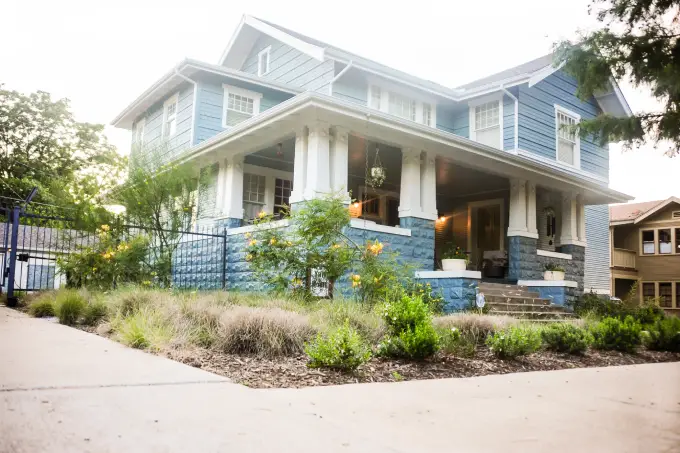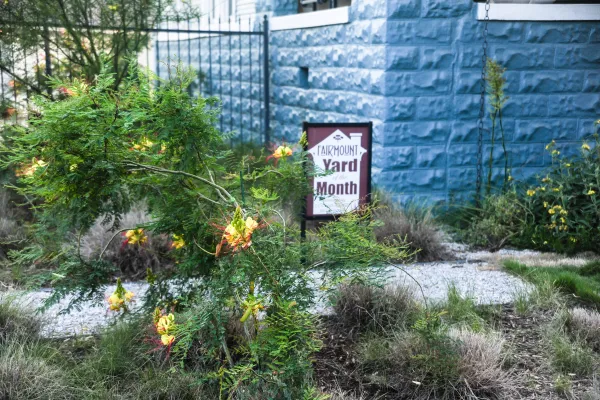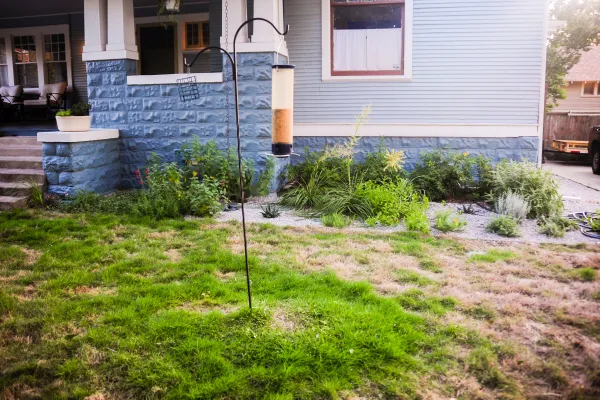1320 S. Adams – Yard of the Month (June 2017)
June 13, 2017
Yard of the Month
Susan and Dusty Fillmore, owners of 1320 S. Adams, a two-story, American Foursquare home with some transitional Craftsman features, own June 2017 Yard of the Month. Foursquare homes, popular between 1890 and 1930, often display pleasingly boxy symmetry, 2.5 stories, a “monitor dormer” facing the street, 12-light over single pane casement windows, and a deeply recessed porch that extends across the front façade (www.oldhouseweb.com). Foursquares may vary siding materials on the first and second floor exterior, a contrast accentuated with complementary shades of paint. 1320 S. Adams is teal over robin’s egg blue with white trim, highlighted by doors painted Benjamin Moore’s “Anjou Pear.” The porch of dimpled cinder block is lined by non-tapering joined pairs of square columns supporting the deeply hipped roof.

The Fillmores have lived in the house since 2015; it was previously owned by the Lystigs from 2002-2015. 1320 S. Adams was built prior to 1910 on then unpaved “Lynch Road.” 1910 Sanborn Fire maps show a two-story carriage house and stable at the rear of the property. Before the 1951 Sanborn maps, the home and its outbuildings had been converted into apartments (http://historicfairmount.com). The Fillmores, who had previously lived in suburban environments, sought walkable, neighborly and historic neighborhoods as they were downsizing after their children went college. They wanted a home with enough space for their four kids to visit, but not so comfortable that everyone would be tempted to move in. 1320 provided the perfect mix of multiple floors and bedrooms, shared bathrooms and communal spaces. There is some historical irony in their wish to avoid running a boarding house as 1320 S. Adams spent 70 years as multi-family rental housing (1930-2000). A massive exterior staircase attached to the sleeping porch allowed access to the upstairs residences; it was removed c. 2000, when the home was converted back to a single family dwelling. 1320 S. Adam’s proximity to Magnolia and public transit, as well as its grand size, made it a desirable location for those who moved to Fort Worth for job opportunities. Its rich history offers a valuable aperture into Fairmount’s past, as our population responds in periods of economic flux.
The 1940 US Census allows us to peep into 1320 S. Adams’ windows, and glimpse the lives of 14 occupants in 7 apartments (1940censusarchives.gov). The inhabitants are surprisingly similar to 21st century Fairmounters: they are entrepreneurs, healthcare workers, single moms, contractors and tradespeople, young couples compelled to leave college to earn money, and people over 60 who cannot afford to retire. They stressed about money and taxes, as we do, but not about parking, as Fairmount had a streetcar connecting residents to downtown. Zula F. Nicholson, a single mom to Jo Lynne, 12, had no wages to purchase a car, and she was not unique: 220,000 North and Central Texans went on welfare after 1939’s widespread drought and crop failure cost many their agriculture jobs (https://tshaonline.org/handbook/online/articles/ncw01). Four young married couples from Waco lived at 1320 in 1940; most studied a few semesters at Baylor before migrating North. Waco had two New Deal construction projects in the late 1930’s; Fort Worth boasted more than 30, including Farrington Stadium, the Botanic Gardens, Will Rogers Memorial Center, and Lily B. Clayton and Alice E Carlson Elementary Schools, formerly 4-room schoolhouses upgraded with offices, auditoriums and gymnasiums (livingnewdeal.org). Naturally, Fort Worth would be attractive to M. H. Hall, 19, head of household in apartment 2, where he lived with wife Frances, 19. Hall, who began working at age 15 as an ornamental iron molder, but also went to Baylor for a year, had valuable talents in Fort Worth, where many Art Deco and Art Moderne buildings like the Eldon B. Mahon Courthouse on W. 10th St., have grilles in Mayan and Egyptian motifs (fortwortharchitecture.com). J.S. Hampton, 25, living in the next unit with wife Gwindella, 20, was a building engineer for the WPA, and the highest-earning occupant of 1320, at $1000 a month. Bosque-county natives Robert and Virginia Campbell, 21 and 19, were bank clerks with a year of college each. Cattlehand Charles Renfro, 28, had seasonal work in the Fort Worth Stockyards; his wife, Mattie Lou, 26, had a beauty shop, where neighbor Amalie Coates, 45, as a manicurist. Rebecca McCallum, 48, who lived with daughter Reba, 19, made $750 a month teaching literacy and citizenship at the “Adult Mexican WPA school.” Despite a 4-year degree from a Missouri Teacher’s College, McCallum’s salary was half that of public school teachers Grace Bradley, 43, and Pearl Badger, 39, at 1326 S. Adams, yet she was at the top of the WPA wage scale (tshaonline.org). Bernice Barnum, 56, made $75 a month as a WPA nurse at Elmwood Sanatorium, while her sister Ella Scott, 65, earned twice that as a women’s wear clerk in a downtown department store. Elmwood Sanatorium (1920-1970) was a combination TB hospital and old folks’ home on Kimbo; remodeled in 1937 by architect Preston Geren, who also designed Farrington Field, Elmwood was replaced by a juvenile detention center in the ‘70’s.
Historical pictures show that while the building was a multi-family dwelling, landscaping was minimal, and the yard had heavy foot traffic that would make it inhospitable to most plants. The Lysigs planted a traditional, English cottage style garden with boxwood shrubbery flanking the porch, irises circling the feet of numerous trees, and rose beds lining the walks After purchasing the home, the Fillmores made the front yard their first redecorating priority. From the inherited plan, the Fillmores retained only a Montezuma bald cypress (taxodium mucronatum), a crape myrtle in the parkway, and a pecan tree on the shared driveway with 1316. Susan knew she wanted to replant with water-wise southwest natives that set the home’s paint colors off with a spectrum of absinthe, chartreuse, and amber. To execute her vision, the Fillmores employed award-winning DFW nursery and design firm, Redenta’s, and gave them strict instructions to avoid pink. For her ever-increasing population of feline friends — cats are always Fairmount’s first welcoming committee — Susan permitted a touch of soft purple, in the form of a flowering cat mint (nepeta nepetella, hardier than the short-lived nepeta cataria in our climate).
The design plan uses multiple examples of a restricted varieties of shrubs and grasses, for a studied and pleasing effect. More than 2 dozen Mexican feather grasses provide a soft carpet between the driveway and the front path (Nassella tenuissima). In the two square lawns, the Fillmores planted a profusion of turf substitutes, which would give the soft appearance of a lawn without the negative environmental impact. To make a handsome groundcover that does not require pesticides, copious watering or mowing, they installed Zoysia, or “no mow grass” (zoysia tenufolia), sometimes called “Korean grass,” as well as multiple Texas sedge (carex texensis), and “Blonde Ambition” blue grama grass (bouteloua gracilis), a native ornamental grass with chartreuse flowers named Plant Select Gardeners best perennial of 2013. Each side of the porch is flanked with Texas frog fruit (phyla nodiflora), a spreading perennial herb in the verbena family with a small white blossom, providing a good nectar fruit for butterflies, which meets up with silver sage on the left and lavender and cat mint on the right. A dozen sweet myrtles, (myrtus communis), a small evergreen shrub with fragrant white flowers, line the sidewalk.
Some of the Fillmore’s yard features “friendship plants,” gifts from neighbors like Angela Doskocil Gaither and others. On the porch, large white circular planters are filled with a variety of succulents from former neighbors Goose Gossen and Laura Herz-Hall. The porch also displays their chromium ceramic planter that happened to match her new front doors, which they passed on as they were moving to Seattle last winter. Flanking the driveway, and visible through the open metal gate, are three yellow Bird of Paradise trees (Caesalpinia pulcherrima), a showy flowering shrub in the pea family, excellent for our hot summers. A Jerusalem thorn, or Retama, nestles among the Birds of Paradise; like them, it is a small tree, amazingly heat tolerant, with saffron blossoms that attract bees. Other lemony plants planted here have medicinal histories, like euphorbia, or “donkey spurge” whose milky sap is a powerful emetic; medicinal herb St. John’s wort, (hypericum perforatum), thought to treat depression; and yellow evening primrose, used as remedy for laziness by the Cherokees. All the flower beds are dressed in grey rock rather than mulch, for another cool note in the visual mix. After more than 70 years of hosting many residents, 1320 S. Adams’s front yard at last expresses the personality of just one family, conveying a modern take on a lawn and flower beds complementary to an historic home.
Our thanks, and a gift certificate to CC’s Touch of Nature, go to the Fillmores.
The Yard of the Month committee is Susan Taylor Harper and Bonnie Blackwell.
- Share




